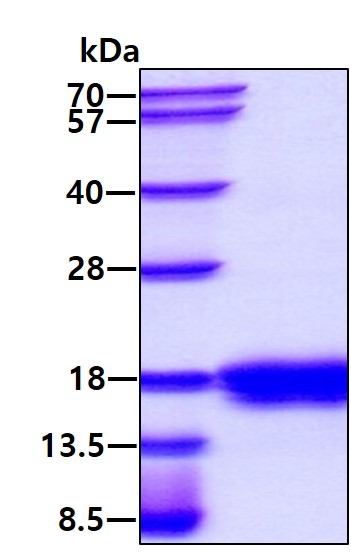Product Info Summary
| SKU: | PROTP20826 |
|---|---|
| Size: | Starting from 10ug |
| Source: | E. coli |
| Application: | SDS-PAGE, Bioactivity |
Customers Who Bought This Also Bought
Product info
Product Name
Mouse SCF/c-kit Ligand Recombinant Protein
View all SCF/c-kit Ligand recombinant proteins
SKU/Catalog Number
PROTP20826
Size
Starting from 10ug
Tag
Non-Tagged
Description
Mouse SCF/c-kit Ligand Recombinant Protein expressed in E. coli (non-tagged). Sequence domain: 26-189aa. Application(s): SDS-PAGE, Bioactivity. Endotoxin: < 1 EU per 1ug of protein (determined by LAL method).
Storage & Handling
Can be stored at 2°C to 8°C for 1 week. For long-term storage, aliquot and store at -20°C to -80°C. Avoid repeated freeze-thaw cycles. (Ships with gel ice.)
Cite This Product
Mouse SCF/c-kit Ligand Recombinant Protein (Boster Biological Technology, Pleasanton CA, USA, Catalog # PROTP20826)
Form
Liquid
Formulation
Phosphate-Buffered Saline (pH 7.4) containing 10% glycerol
Concentration
1mg/ml (determined by Bradford assay)
Purity
> 95% by SDS-PAGE
Predicted MW
18 kDa (165aa) confirmed by MALDI-TOF
Endotoxin
< 1 EU per 1ug of protein (determined by LAL method)
Amino Acid Sequence
Mouse, P20826, 26-189aa; MKEICGNPVT DNVKDITKLV ANLPNDYMIT LNYVAGMDVL PSHCWLRDMV IQLSLSLTTL LDKFSNISEG LSNYSIIDKL GKIVDDLVLC MEENAPKNIK ESPKRPETRS FTPEEFFSIF NRSIDAFKDF MVASDTSDCV LSSTLGPEKD SRVSVTKPFM LPPVABioactivity
Measured in a cell proliferation assay using MC/9 mouse mast cells. The ED50 range ≤7 ng/ml.Assay dilution & Images
Validation Images & Assay Conditions

Click image to see more details
3ug by SDS-PAGE under reducing condition and visualized by coomassie blue stain.

Click image to see more details
Mouse SCF/c-kit Ligand stimulates cell proliferation of the MC/9 mouse mast cells. The ED50 range ≤7 ng/ml.
Protein Target Info & Infographic
Gene/Protein Information For Kitlg (Source: Uniprot.org, NCBI)
Gene Name
Kitlg
Full Name
Kit ligand
Weight
18 kDa (165aa) confirmed by MALDI-TOF
Superfamily
SCF family
Alternative Names
Kit ligand, KITLG, Mast cell growth factor, MGF, Stem cell factor, SCF, c-Kit ligand, Steel factor, SF, Kitl, Hematopoietic growth factor KL, KL-1, Familial progressive hyperpigmentation 2, FPH2, SLF, blz, Gb, Grizzle-belly, SL KITLG DCUA, DFNA69, FPH2, FPHH, KL-1, Kitl, MGF, SCF, SF, SHEP7, SLF KIT ligand kit ligand|c-Kit ligand|familial progressive hyperpigmentation 2|mast cell growth factor|steel factor|stem cell factor
*If product is indicated to react with multiple species, protein information is based on the gene entry specified above in "Species".For more info on Kitlg, check out the Kitlg Infographic

We have 30,000+ of these available, one for each gene! Check them out.
In this infographic, you will see the following information for Kitlg: database IDs, superfamily, protein function, synonyms, molecular weight, chromosomal locations, tissues of expression, subcellular locations, post-translational modifications, and related diseases, research areas & pathways. If you want to see more information included, or would like to contribute to it and be acknowledged, please contact us at [email protected].
Specific Publications For Mouse SCF/c-kit Ligand Recombinant Protein (PROTP20826)
Hello CJ!
No publications found for PROTP20826
*Do you have publications using this product? Share with us and receive a reward. Ask us for more details.
Recommended Resources
Here are featured tools and databases that you might find useful.
- Boster's Pathways Library
- Protein Databases
- Bioscience Research Protocol Resources
- Data Processing & Analysis Software
- Photo Editing Software
- Scientific Literature Resources
- Research Paper Management Tools
- Molecular Biology Software
- Primer Design Tools
- Bioinformatics Tools
- Phylogenetic Tree Analysis
Customer Reviews
Have you used Mouse SCF/c-kit Ligand Recombinant Protein?
Submit a review and receive an Amazon gift card.
- $30 for a review with an image
0 Reviews For Mouse SCF/c-kit Ligand Recombinant Protein
Customer Q&As
Have a question?
Find answers in Q&As, reviews.
Can't find your answer?
Submit your question





